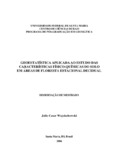| dc.creator | Wojciechowki, Julio César | |
| dc.date.accessioned | 2007-11-27 | |
| dc.date.available | 2007-11-27 | |
| dc.date.issued | 2006-08-07 | |
| dc.identifier.citation | WOJCIECHOWKI, Julio César. Geostatístics applied to the study of soil physiochemical characteristics in seasonal deciduous forest areas. 2006. 103 f. Dissertação (Mestrado em Geociências) - Universidade Federal de Santa Maria, Santa Maria, 2006. | por |
| dc.identifier.uri | http://repositorio.ufsm.br/handle/1/9486 | |
| dc.description.abstract | It was used methods of classic statistics, exploratory data analysis and geostatistics in the identification of size and structure of space variability of some physiochemical attributes of soils under seasonal deciduous forest areas, which was called mature forest, secondary forest
and capoeirão . The areas, located in Santa Tereza, RS State, were sampled during the period from 2002 to 2003, comprising the soil classes: Argiluvic Chernosol, Cambisol Ta and Litholic Neosol. Systematic sampling was performed with regular spacing grid of points varying of 30 m for capoeirão and 40 m for mature and secondary forest, in an amount of
80 sample points in a total area of 7.34 ha. In each point measurements "in situ" were made of the soil bulk density, clay content, pH, potassium, organic matter and phosphorus. The magnitudes of the space variability were given by the variation coefficients, while the structure was identified through the variograms, being defined the needed parameters for the Kriging. The most variable attribute was the organic matter, didn t being adjusted to any model of variogram, while the pH was the less. In the analysis of structure of the space
variability through the geostatistics, the clay and bulk density, both in area of secondary forest, and pH in the experimental areas had showed the biggest space dependence. The gauss model for the clay attribute obtained the largest reach (a), being respectively 400 m and 388 m
in the areas of secondary and mature forest respectively. The crossed validation showed accuracy in the variographic models adjustment, being the pH variable the one which
presented the optimum performance, 0.87; 0.94 and 0.92 in the areas of mature forest, secondary forest and capoeirão respectively. The ordinary Kriging of the interest variable
allowed the detailing of distribution of these variable from the isoline maps. All of the variograms models for most of the studied attributes, presented anisotropic influence zones,
being the larger space variability in perpendicular direction to the slope of these areas. | eng |
| dc.format | application/pdf | por |
| dc.language | por | por |
| dc.publisher | Universidade Federal de Santa Maria | por |
| dc.rights | Acesso Aberto | por |
| dc.subject | Geoestatística | por |
| dc.subject | Variabilidade espacial | por |
| dc.subject | Solos florestais | por |
| dc.subject | Floresta estacional | por |
| dc.subject | Geostatistics | eng |
| dc.subject | Space variability | eng |
| dc.subject | Forest soils | eng |
| dc.subject | Deciduous forest | eng |
| dc.title | Geoestatística aplicada ao estudo das características físico-químicas do solo em áreas de floresta estacional decidual | por |
| dc.title.alternative | Geostatístics applied to the study of soil physiochemical characteristics in seasonal deciduous forest areas | eng |
| dc.type | Dissertação | por |
| dc.description.resumo | Utilizou-se métodos da estatística clássica, análise exploratória de dados e da geoestatística na
identificação do tamanho e da estrutura da variabilidade espacial de alguns atributos físicoquímicos
do solo em áreas de Floresta Estacional Decidual, as quais foram denominadas floresta madura, floresta secundária e capoeirão. As áreas, localizadas no município de Santa
Tereza - RS, foram amostradas durante o período de 2002 a 2003, compreendendo as classes de solo: Chernossolo Argilúvico, Cambissolo Ta e Neossolo Litólico. Realizou-se
amostragem sistemática com grid de espaçamento regular entre os pontos variando de 30 m para o capoeirão e 40 m para floresta madura e secundária, totalizando 80 pontos amostrais em uma área total de 7.34 ha. Foram coletadas amostras de solo in situ para análise em laboratório dos atributos densidade, argila, pH, potássio, matéria orgânica e fósforo. As magnitudes da variabilidade espaciais foram dadas pelos coeficientes de variação, enquanto que a estrutura foi identificada por meio dos semivariogramas, definindo-se os parâmetros necessários para a krigagem. O atributo mais variável foi a matéria orgânica, não obtendo ajuste a nenhum modelo teórico de semivariograma, enquanto que o pH foi o menor. Na análise de estrutura da variabilidade espacial através da geoestatística, a argila e densidade, ambas em área de floresta secundária, e o pH nas áreas experimentais apresentaram a maior dependência espacial. O modelo gaussiano para o atributo argila obteve o maior alcance da
dependência espacial, sendo 400 e 388 m, nas áreas de floresta secundária e madura respectivamente. A validação cruzada mostrou acuracidade no ajuste dos modelos
variográficos, tendo a variável pH apresentado o melhor desempenho, 0.87; 0.94 e 0.92 nas áreas de floresta madura, secundária e capoeirão respectivamente. A krigagem ordinária das variáveis de interesse permitiu o detalhamento da distribuição dessas variáveis a partir dos mapas de isolinhas. Todos os modelos de semivariogramas apresentaram zonas de influência anisotrópicas, tendo sua variabilidade espacial maior no sentindo perpendicular a declividade destas áreas. | por |
| dc.contributor.advisor1 | Schumacher, Mauro Valdir | |
| dc.contributor.advisor1Lattes | http://lattes.cnpq.br/4577505947479643 | por |
| dc.contributor.referee1 | Pires, Carlos Alberto da Fonseca | |
| dc.contributor.referee1Lattes | http://lattes.cnpq.br/7702592555087426 | por |
| dc.contributor.referee2 | Madruga, Pedro Roberto de Azambuja | |
| dc.contributor.referee2Lattes | http://lattes.cnpq.br/6881563409114963 | por |
| dc.publisher.country | BR | por |
| dc.publisher.department | Geociências | por |
| dc.publisher.initials | UFSM | por |
| dc.publisher.program | Programa de Pós-Graduação em Geomática | por |
| dc.subject.cnpq | CNPQ::CIENCIAS EXATAS E DA TERRA::GEOCIENCIAS | por |


